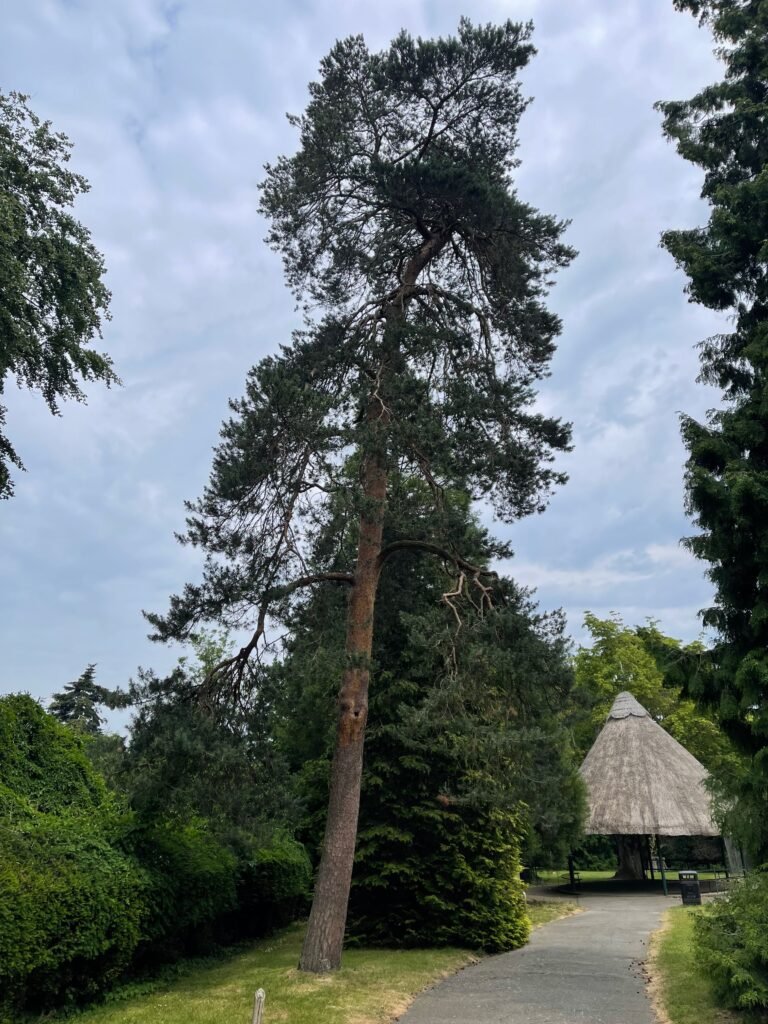Pine, Scots
The Scots Pine (UK), Scotch Pine (US), is a truly stunning evergreen conifer, that can grow to a height of 35m, and may live for 700 years.
A tall straight pine tree. The scaly bark is istinctive orange-brown, which develops plates and fissures with age. Twigs are green-brown and hairless.

Photo supplied by: Alan Payne
Common Name:
Scots Pine
Scentific Name:
Pinus sylvestris
Tree No:
78
Location:
C11

The needle-like leaves are blue-green and slightly twisted, and grow in pairs on short side shoots.

Credit: This could be your image
Scots pine is monoecious, meaning both male and female flowers grow on the same tree. Male flowers comprise clusters of yellow anthers at the base of shoots. Female flowers are small, red-purple and globular, and grow at the tips of new shoots.

Credit: This could be your image
After pollination by wind, the female flowers turn green and develop into cones. They mature the following season, so there are always cones of different ages on the one tree. Mature cones are grey-brown with a raised, circular bump at the centre of each scale.

Credit: This could be your image
Scots pine is the only truly native pine in the UK. It thrives in heathland and is widely planted for timber, but is also found in abundance in the Caledonian pine forest in the Scottish Highlands.
The Caledonian forest is a priority habitat under the UK Biodiversity Action Plan and is home to many rare species. Mammals include red squirrel, pine marten and Scottish wildcat. Scots pines in southern England are also the main caterpillar foodplant for the pine hawk-moth.
When used for commercial production of timber rotations of 50 to 120 years are normal. Its valuable timber is used for wood pulp and sawn timber.
Scots pine timber is one of the strongest softwoods available and is widely used in the construction industry for joinery. It is used in the manufacture of telegraph poles, pit props, gate posts and fencing. The tree can also be tapped for resin to make turpentine. Other uses have included rope made from the inner bark, tar from the roots and a dye from the cones. Dry cones can be used as kindling for fires.
Optional Content.
Tree Listings
Holme Oak
Oak, Holme The Holm Oak, is a broadleaf evergreen tree, that can grow to a height of over 20m, and may live for 400 years. The crown is broad, domed, with ascending branches and often with low stems. The bark is black and finely cracked, and the twigs are slender and...
English Oak
Oak, English The English Oak, the majesty of the woods, is a broadleaved deciduous tree, that can grow to a height of 40m, and may live for 1,000 years. This species grows and matures to form a broad and spreading crown with sturdy branches beneath. Photo...
English Oak
Oak, English The English Oak, the majesty of the woods, is a broadleaved deciduous tree, that can grow to a height of 40m, and may live for 1,000 years. This species grows and matures to form a broad and spreading crown with sturdy branches beneath. This tree was...
Red Maple
Maple, Red The Red Maple, is a striking broadleaved deciduous tree, that can grow to a height of 20m, and may live for 200 years, although 80 to 100 years may be more typical. This tree was planted in memory of Mr Hungerford Rowley, a long and respected resident of...
Red Maple
Maple, Red The Red Maple, is a striking broadleaved deciduous tree, that can grow to a height of 20m, and may live for 200 years, although 80 to 100 years may be more typical. Photo supplied by: Alan PayneCommon Name:Red Maple Scentific Name:Acer rubrum Tree...
Norway Maple
Maple, Norway The Norway Maple, is a broadleaved deciduous tree, that can grow to a height of 25m, and may live for 150 years. The bark is grey with fine ridges, and the twigs are slender and brown with tiny white spots. Photo supplied by: Alan PayneCommon...
Norway Maple
Maple, Norway The Norway Maple, is a broadleaved deciduous tree, that can grow to a height of 25m, and may live for 150 years. The bark is grey with fine ridges, and the twigs are slender and brown with tiny white spots. Photo Supplied By: Alan PayneCommon...
Field Maple
Maple, Field The Field Maple, is a sturdy broadleaved deciduous tree, that can grow to a height of 20m, and may live for 350 years. The bark is light brown and flaky, and twigs are slender and brown and develop a corky bark with age. Small, grey leaf buds grow on long...
Common Lime
Lime, Common The Common Lime, a hybrid between small-leaved and large-leaved lime, is a broadleaved deciduous tree, that can grow to a height of 40m, and may live for 400 years. The bark is pale grey-brown and irregularly ridged, with characteristic large burrs and...
Horse Chestnut
Horse Chestnut The Horse Chestnut, with its shiny mahogany conkers, is a broadleaved deciduous tree, that can grow to a height of 40m, and may live for 300 years. The bark is smooth and pink-grey when young, which darkens and develops scaly plates with age. Twigs are...
English Elm
Elm, English The English Elm, is a deciduous tree, that can grow to a height of 30m, and may live more than 100 years. The bark is grey-brown, rough and fissured, often with suckers growing from the base of the trunk. The twigs are finely hairy. Photo supplied...
Lawson Cypress
Cypress, Lawson The Lawson Cypress, is an evergreen conifer, that can grow to a height of 45m high, and may live more than 500 years. A tall, narrowly conical tree, with feathery foliage. The bark is cracked into vertical plates, and the twigs are a dark...
Braintree & Bocking Public Gardens,
43 Bocking End,
Braintree,
CM7 9AE.
Open 9:00 to 4:00pm – January, February.
Open 9:00 to 6:00pm – March.
Open 9:00 to 7:00pm – April.
Open 9:00 to 8:00pm – May, June, July, August.
Open 9:00 to 7:00pm – September.
Open 9:00 to 6:00pm – October.
Open 9:00 to 4:00pm – November December.
Note – The gates are locked at dusk.
Dusk is subject to seasonal variation, so closing times may not be exactly to the schedule, at the transitions.
No dogs allowed in the gardens.
No alcohol to be consumed in the gardens.
No riding of cycles or scooters in the gardens.
General Enquiries
Phone: 01376 773066
Email: info@braintreeandbockinggardens.co.uk
Tennis Enquiries
Phone: 01376 773070
Email: tennis@braintreeandbockinggardens.co.uk
© Braintree & Bocking Public Gardens Trust 2017-2021. All Rights Reserved.
Registered Charity Number 212989
Get in touch


Braintree and Bocking Public Gardens
We provide, maintain and preserve these unique and beautiful gardens as a community green space.